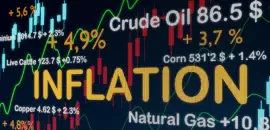Triggered by the COVID-19 pandemic, the U.S. and global economy have confronted a series of supply shortages that caused prices of many goods to surge. Heading the list were prices for lumber, used cars, car rentals and computer chips.
Last year, Fed Chair Jerome Powell reassured consumers and investors that the spike in inflation was temporary and there was no need for the Fed to tighten monetary policy. This view appeared to be credible when lumber prices tumbled in the second quarter and prices for used cars stabilized the following quarter.
However, Powell changed his tune by September 2021 when he acknowledged that prices had stayed elevated longer than the Fed envisioned. According to Reuters, Powell told a conference of European central bankers that, “It’s…frustrating to see the bottlenecks and supply chain problems not getting better, in fact at the margin apparently getting a little bit worse.” He went on to acknowledge the problems could continue into next year “holding inflation up longer than we thought.”
Background: Supply Chain Challenges
Last year, one of the most visible signs of the supply-and-demand imbalance was the backlog of container ships idling offshore at the ports of Los Angeles and Long Beach. Amy Davidson Sorkin of the New Yorker claimed labor shortages were at the heart of the problem, as there were not enough dockworkers to unload cargo or truck drivers to move the contents to distribution centers.
The good news is these problems have been alleviated. According to a Wall Street Journal report, the queue of ships waiting to unload cargo at these ports was down to four last week. This is attributable to an improved queuing system, as well as to declining U.S. import volumes and a diversion of ships to the East and Gulf ports.
Other measures also indicate that supply-chain problems have eased considerably. For example, the New York Fed’s Global Supply Chain Pressure Index (GSCPI) decreased in September for the fifth consecutive month (see figure below). The index is now one standard deviation above the historical average, down from a peak of four standard deviations earlier this year. The GSCPI integrates several commonly-used metrics to gauge supply chain pressures. They include transport costs from the Baltic Dry Index and Harper index, airfreight cost indices compiled by the BLS, and various components from purchasing managers indices for seven major economies.

Why Has Inflation Remained High?
Yet, despite the drop in goods prices, inflation remains stubbornly high in the U.S., EU and other areas.So, what does this tell us about the process of inflation?
My take is that Fed officials and policy makers abroad were correct to pinpoint supply-chain disruptions as being the principal cause of the surge in goods prices last year. As these pressures have eased, so have U.S. goods prices. Thus, after rising by 12 percent last year, core goods price increases have slowed to about 7 percent recently. Moreover, the pace is likely to decline further as the global economy weakens.
The reason that overall inflation has stayed high is that services prices, which account for 60% of the CPI, have increased from 2 percent at the beginning of 2021 to 6 percent. The main contributor has been a steady rise in the cost of shelter, which accounts for one-third of the CPI index and one-half of the services component. This includes tenant and owner-equivalent rents, which have been impacted by rising mortgage rates, as well as home prices.
The Fed's Response to Inflation
The shortcomings in the Fed’s assessment of inflation were two-fold. First, officials attributed most of the spike in inflation last year to supply chain problems, but did not take into account the effect that overly-accommodative monetary and fiscal policies had in boosting aggregate demand.
Second, Fed officials initially viewed the process of inflation as static rather than dynamic. By this, I mean that the longer inflation stays elevated the more embedded it becomes in peoples’ expectations. Thus, businesses that face rising input costs at the wholesale level will pass them along at the retail level. Similarly, consumers who confront rising prices for groceries and gasoline will come to anticipate further price increases down the road. The result is a broadening of price pressures over time and increased expectations for both wages and prices.
The Fed now realizes this, which is the principal reason it has tightened policy aggressively, raising the funds rate by 75 basis points at each of the last four FOMC meetings. Some Fed officials have begun to signal that with the funds rate now at 4.0%-4.25%, it is closer to becoming positive after adjusting for inflation expectations. What the Fed has not done, however, is spell out the framework it uses to assess inflation and how it will respond once unemployment begins to rise.
A version of this article was posted to Forbes.com on November 1, 2022.
This publication has been distributed for informational purposes only and should not be considered as investment advice or a recommendation of any particular security, strategy, or investment product. Opinions expressed in this commentary reflect subjective judgments of the author based on the current market conditions at the time of writing and are subject to change without notice. Information and statistics contained herein have been obtained from sources believed to reliable but are not guaranteed to be accurate or complete. Past performance is not indicative of future results.




























